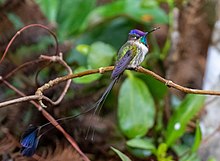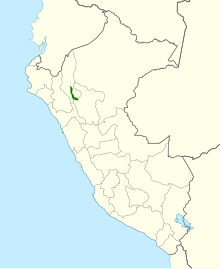| Marvelous spatuletail | |
|---|---|

| |
| Male | |
| Conservation status | |
 Endangered (IUCN 3.1) | |
| CITES Appendix II (CITES) | |
| Scientific classification | |
| Domain: | Eukaryota |
| Kingdom: | Animalia |
| Phylum: | Chordata |
| Class: | Aves |
| Clade: | Strisores |
| Order: | Apodiformes |
| Family: | Trochilidae |
| Tribe: | Heliantheini |
| Genus: | Loddigesia Bonaparte, 1850 |
| Species: | L. mirabilis |
| Binomial name | |
| Loddigesia mirabilis (Bourcier, 1847) | |

| |
| Distribution of Loddigesia mirabilis in Peru | |
The marvelous spatuletail (Loddigesia mirabilis) is an endangered species of hummingbird in the "brilliants", tribe Heliantheini in subfamily Lesbiinae. It is endemic to northern Peru.
Taxonomy and systematics
The marvelous spatuletail is currently (early 2022) treated by worldwide taxonomic systems as the only member of its genus. However, a molecular phylogenetic study of the hummingbirds published in 2014 found that the marvelous spatuletail was embedded in genus Eriocnemis, the "pufflegs". Moving it to Eriocnemis would require that the colorful puffleg (currently E. mirabilis) receive a new specific epithet because the spatuletail's mirabilis has priority.
Description

The male marvelous spatuletail is 15 to 17 cm (5.9 to 6.7 in) long including its 11 to 13 cm (4.3 to 5.1 in) tail. Females are 9 to 10 cm (3.5 to 3.9 in) long with a 5 to 7 cm (2.0 to 2.8 in) tail. The male's signature feature is its two outer tail feathers with bare shafts that cross each other and end in large purplish black racquets or "spatules". The remaining tail feathers are very short and are supported by two long undertail coverts. The female's outer tail feathers are also long, but shorter than the male's, and do not have the racquets.
Both sexes have a slightly decurved black bill and a white spot behind the eye. Males have mostly green upperparts with a blue crest and a brownish hindneck. Their gorget is glossy blue-green and the rest of the underparts are white with a black line down the center. Females are also green above but do not have a crest or gorget. Their underparts are white without the male's black central line.
Distribution and habitat
The marvelous spatuletail is found only in a small area in the Andes of northern Peru. Most records are from the valley of the Utcubamba River in Amazonas Department with a few further east in the Department of San Martín. It inhabits the edges of mature forest, secondary forest, and montane scrublands. It is partial to thickets of thorny Rubus with alder (Alnus). In elevation it ranges between 2,100 and 2,900 m (6,900 and 9,500 ft) though there are unconfirmed reports both higher and lower.
Behavior
Movement
The marvelous spatuletail is a year-round resident of its range.
Feeding
The marvelous spatuletail forages by trap-lining, visiting a circuit of flowering plants where it perches to feed. It is most often seen feeding at a red-flowered lily (Bomarea formosissima) but has been observed feeding in at least five other species of flowering plants. It is dominated by other hummingbird species that share its range.
Breeding
Little is known about the marvelous spatuletail's breeding phenology. Its breeding season appears to be between December and February but may extend from October to May. Males gather at leks and perform an aerial display.
|
Songs and calls Listen to marvelous spatuletail on xeno-canto |
Vocalization
The male marvelous spatuletail gives "a repeated high-pitched buzzy metallic note...'tzzz...tzzz...'" during its aerial display. Its calls include "an upslurred high-pitched sweet note 'tswee'" and "a more strident 'tsik'".
Status
The IUCN originally assessed the marvelous spatuletail as Threatened, then in 1994 rated it as Vulnerable and since 2000 as Endangered. It is known from only two general areas and its population is thought to be smaller than 1000 mature individuals. Deforestation is rampant in its range though the species' preference for edge and scrubby habitats may somewhat ameliorate its effects. Males are hunted for traditional medicine, as their hearts are believed to be an aphrodisiac.
In 2005, American Bird Conservancy provided Peruvian conservation partner ECOAN with support to sign a conservation easement with the Pomacochas Community to protect and manage about 100 acres (0.40 km) of significant habitat for the marvelous spatuletail. Over 30,000 saplings of native trees and bushes have been planted there. This conservation easement is the first of its kind in Peru.
In popular media
The marvelous spatuletail has been featured on the PBS TV series Nature and two BBC TV series, Natural World and Life.
See also
- Booted racket-tails (Ocreatus) - a more widespread genus of Andean hummingbirds with a similar but shorter tail
References
- ^ BirdLife International (2016). "Marvelous Spatuletail Loddigesia mirabilis". IUCN Red List of Threatened Species. 2016: e.T22688130A93183168. doi:10.2305/IUCN.UK.2016-3.RLTS.T22688130A93183168.en. Retrieved 23 April 2022.
- "Appendices | CITES". cites.org. Retrieved 14 January 2022.
- ^ Gill, F.; Donsker, D.; Rasmussen, P., eds. (January 2022). "Hummingbirds". IOC World Bird List. v 12.1. Retrieved 15 January 2022.
- ^ HBW and BirdLife International (2020) Handbook of the Birds of the World and BirdLife International digital checklist of the birds of the world Version 5. Available at: http://datazone.birdlife.org/userfiles/file/Species/Taxonomy/HBW-BirdLife_Checklist_v5_Dec20.zip . Retrieved 27 May 2021
- Clements, J. F., T. S. Schulenberg, M. J. Iliff, S. M. Billerman, T. A. Fredericks, J. A. Gerbracht, D. Lepage, B. L. Sullivan, and C. L. Wood. 2021. The eBird/Clements checklist of Birds of the World: v2021. Downloaded from https://www.birds.cornell.edu/clementschecklist/download/ Retrieved 25 August 2021
- McGuire, J.; Witt, C.; Remsen, J.V.; Corl, A.; Rabosky, D.; Altshuler, D.; Dudley, R. (2014). "Molecular phylogenetics and the diversification of hummingbirds". Current Biology. 24 (8): 910–916. doi:10.1016/j.cub.2014.03.016. PMID 24704078.
- Remsen, J. V., Jr., J. I. Areta, E. Bonaccorso, S. Claramunt, A. Jaramillo, D. F. Lane, J. F. Pacheco, M. B. Robbins, F. G. Stiles, and K. J. Zimmer. Version 31 January 2022. A classification of the bird species of South America. American Ornithological Society. https://www.museum.lsu.edu/~Remsen/SACCBaseline.htm. Retrieved 1 February 2022
- ^ Züchner, T. and P. F. D. Boesman (2020). Marvelous Spatuletail (Loddigesia mirabilis), version 1.0. In Birds of the World (J. del Hoyo, A. Elliott, J. Sargatal, D. A. Christie, and E. de Juana, Editors). Cornell Lab of Ornithology, Ithaca, NY, USA. https://doi.org/10.2173/bow.marspa1.01. Retrieved 23 April 2022
- "A marvellous hummingbird display". 3 November 2009. Retrieved 20 July 2020.
- "Marvelous Spatuletail". American Bird Conservancy. Retrieved 23 April 2022.
- "Marvelous Spatuletail Hummingbird | Huembo | ECOAN | Photography". hummingbirdspot. Retrieved 23 April 2022.
- Nature episode "Hummingbirds: Magic in the Air", 10 January 2010.
- Natural World Episode 5. "Attenborough's Ark: Natural World Special", 9 November 2012
External links
- Marvelous Spatuletail photo gallery at VIREO
| Taxon identifiers | |
|---|---|
| Loddigesia mirabilis |
|
| Trochilus mirabilis | |







